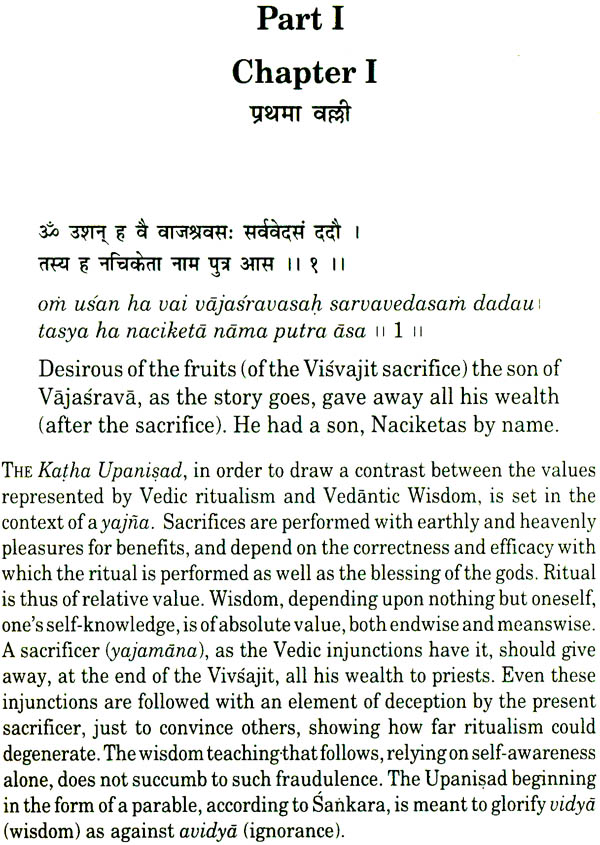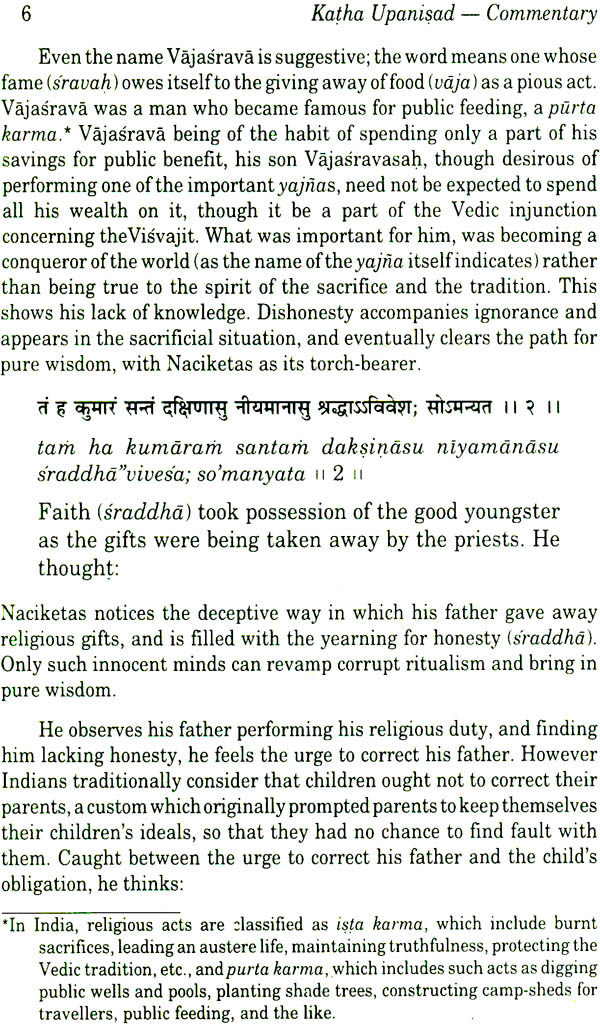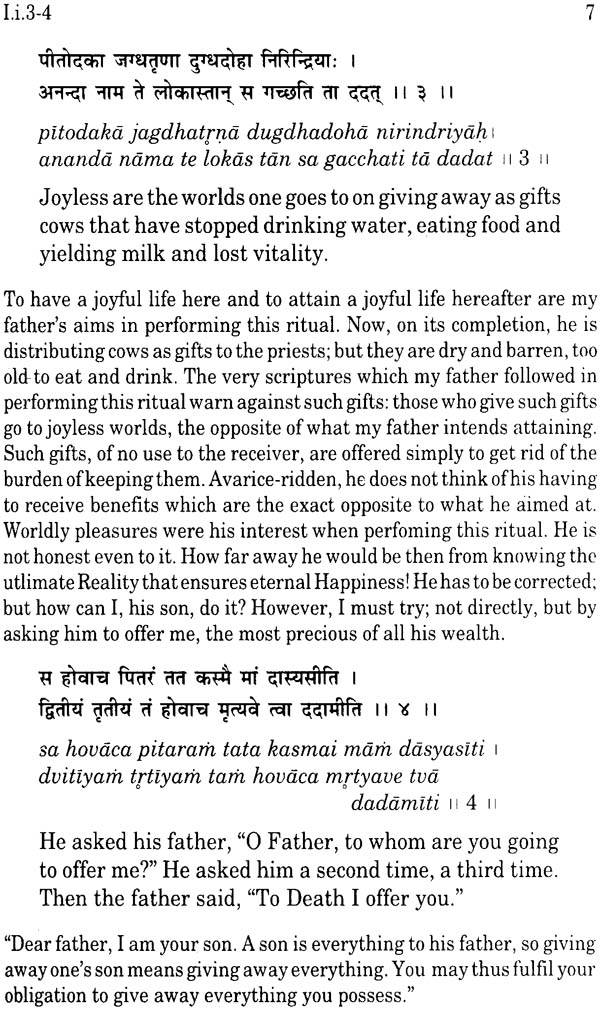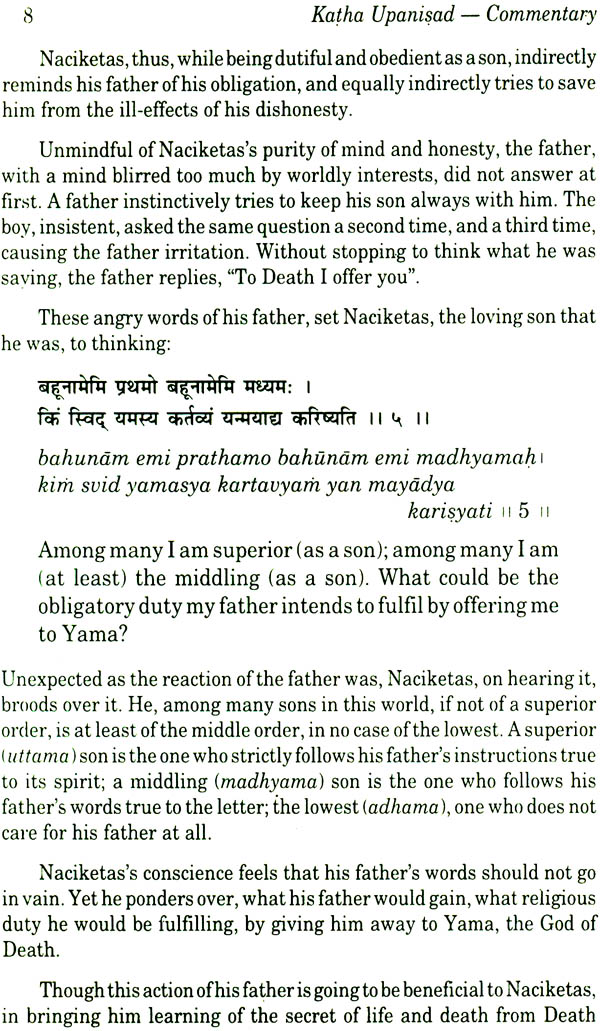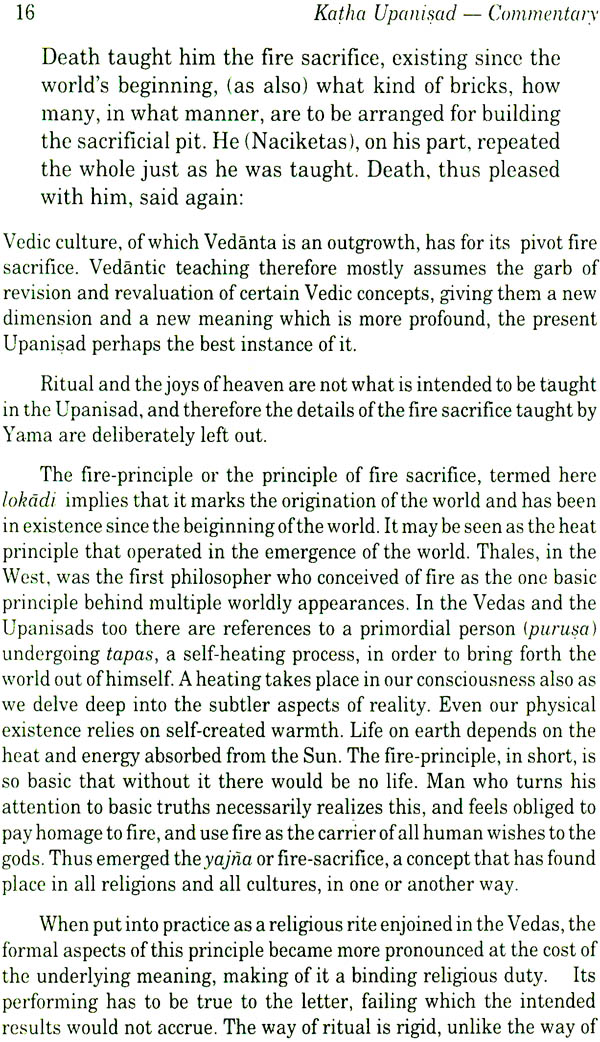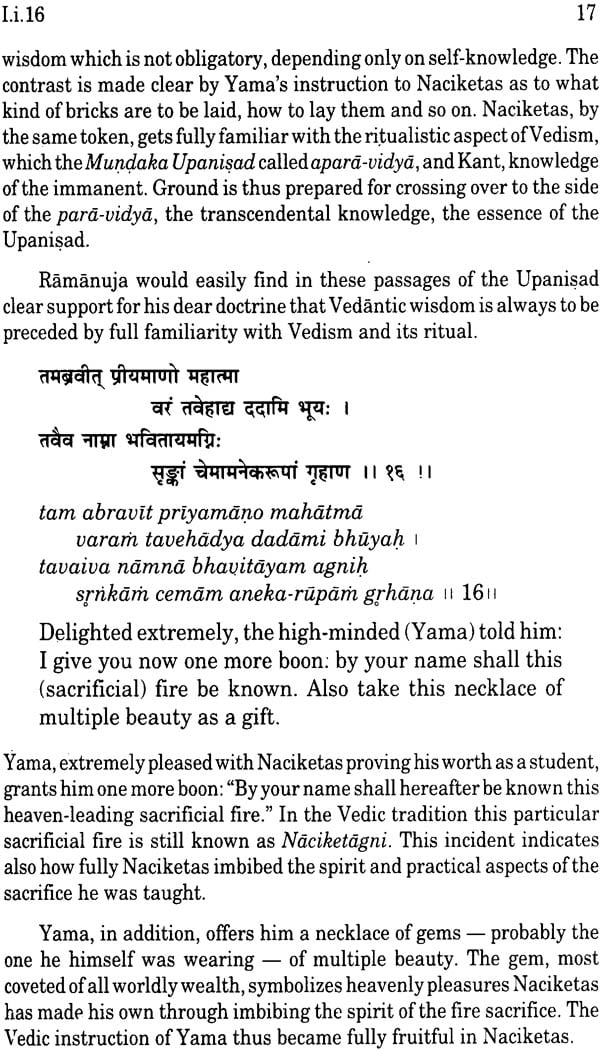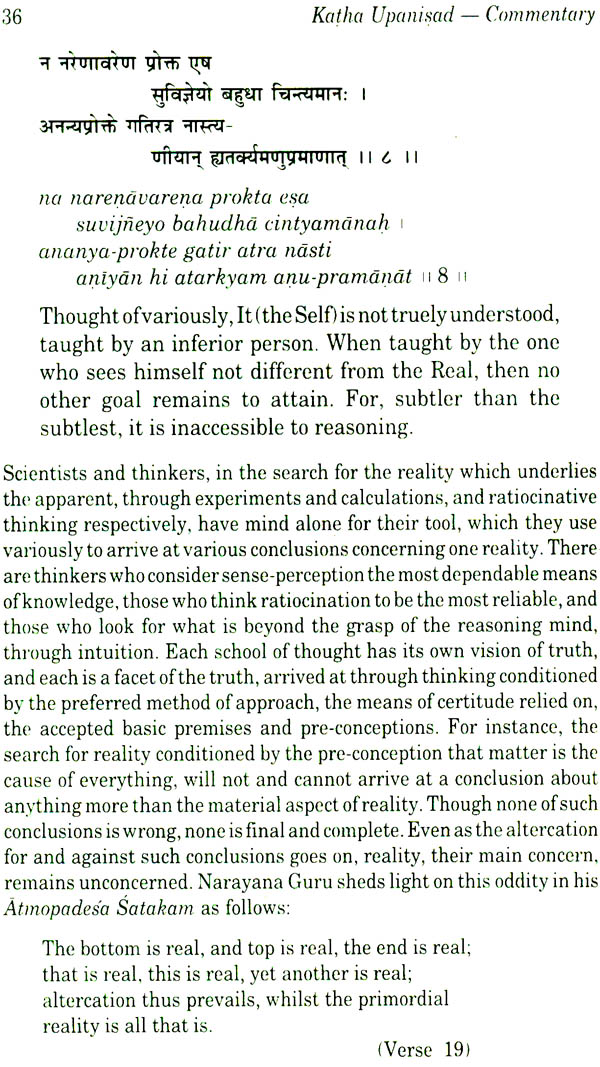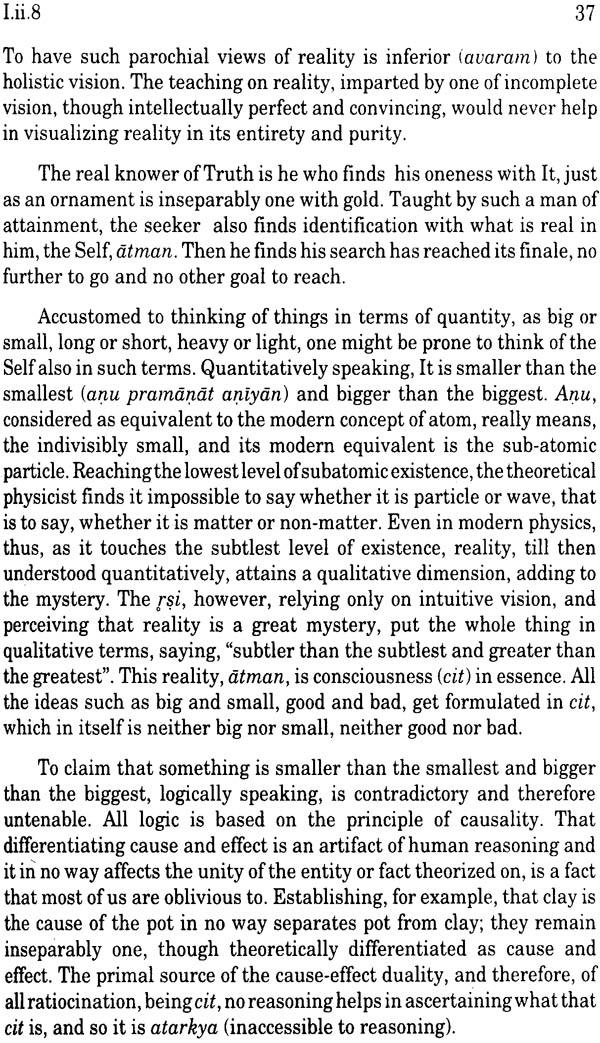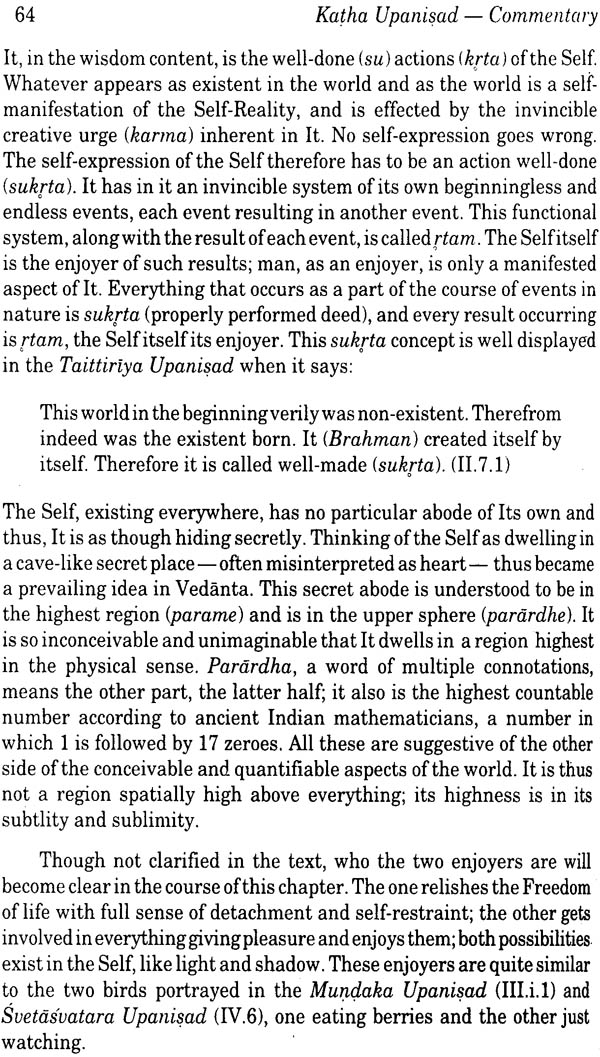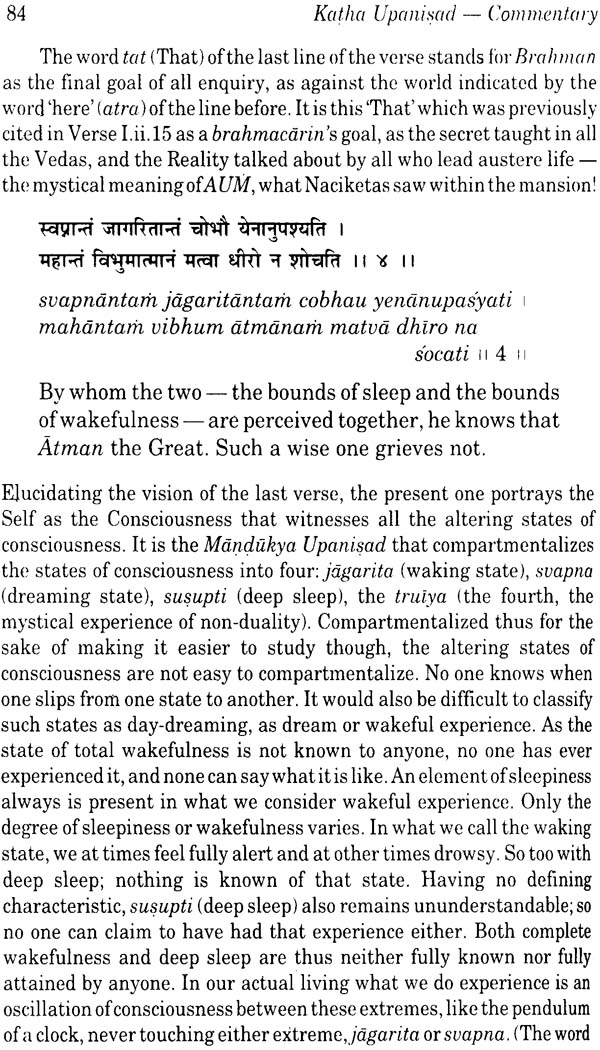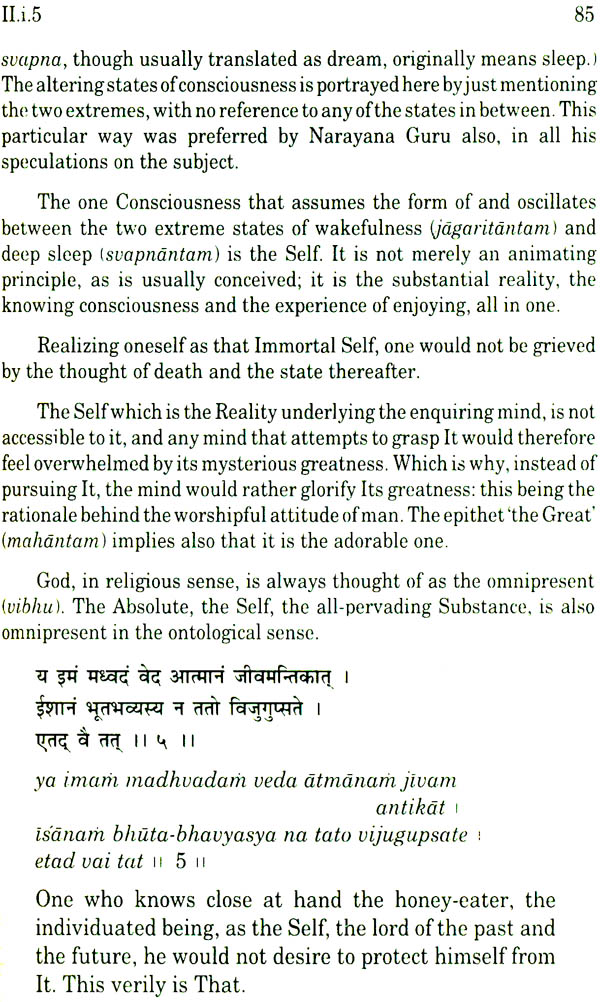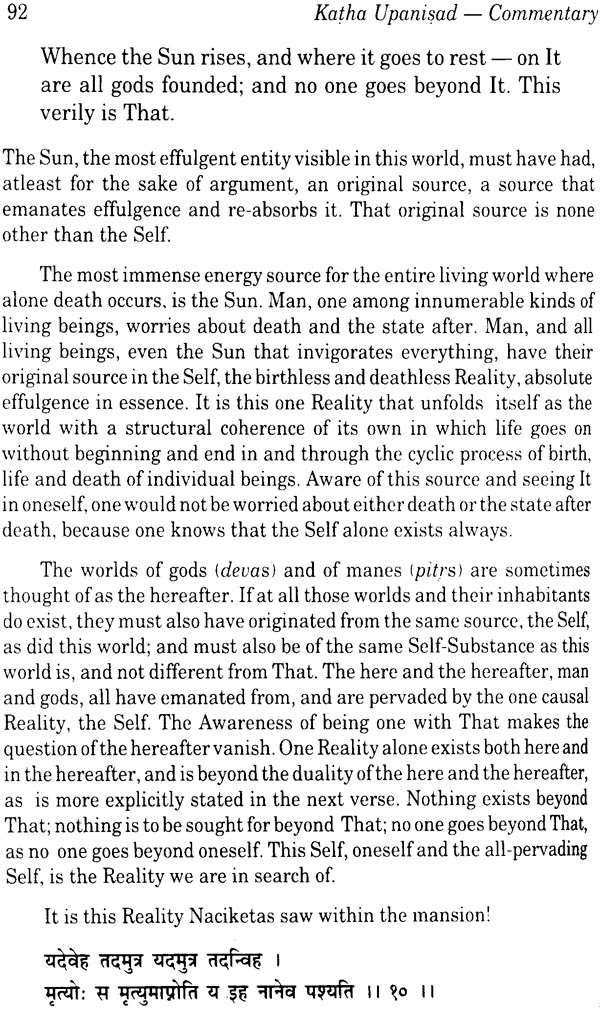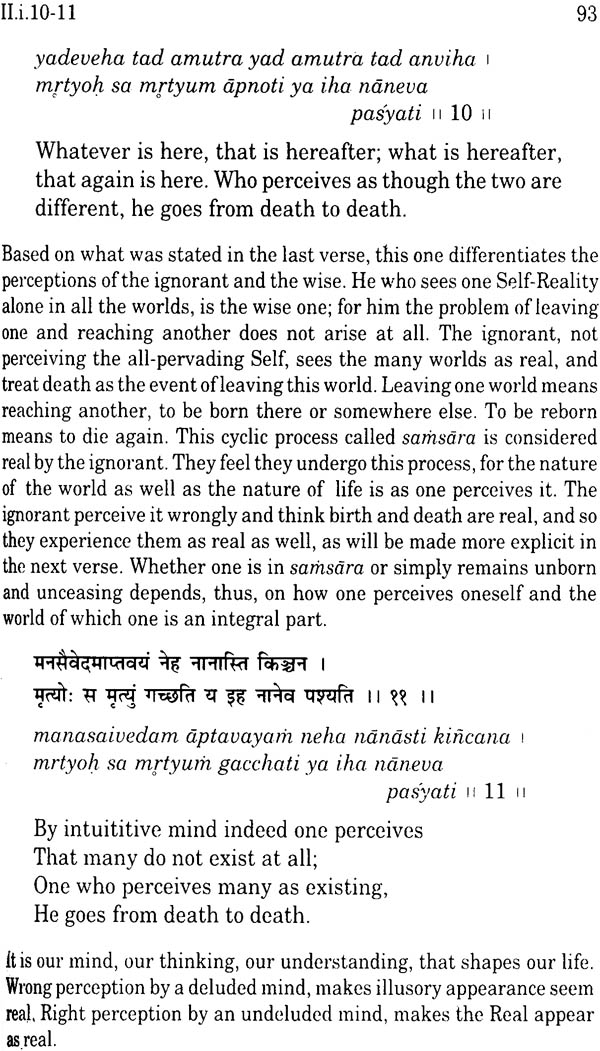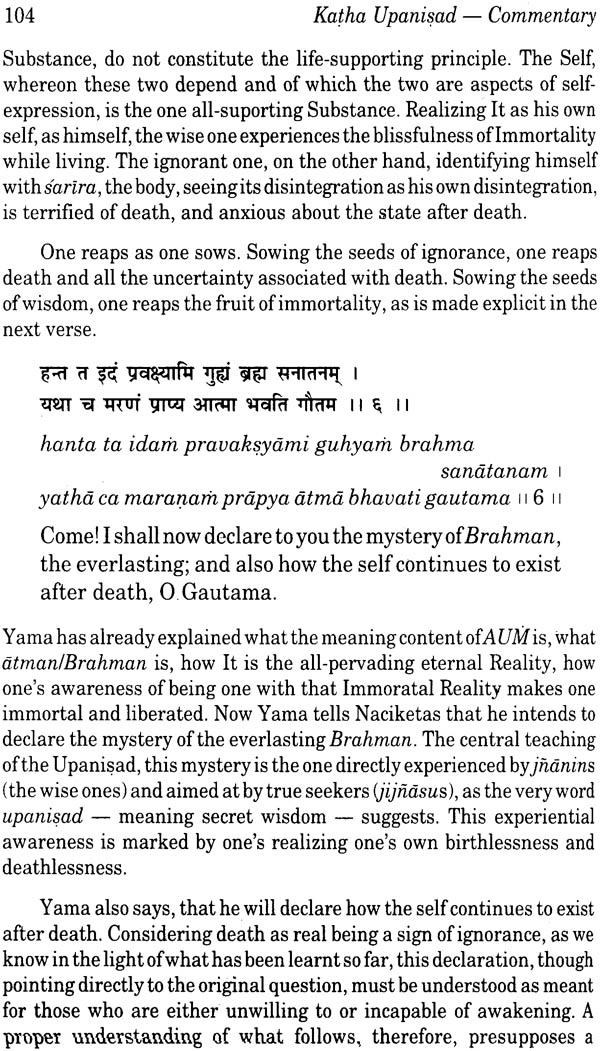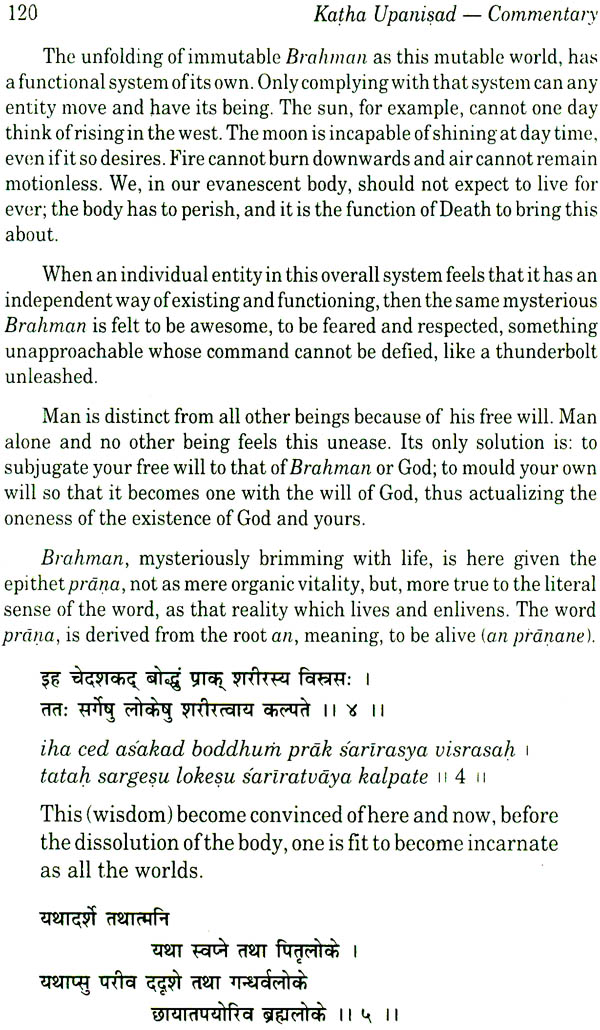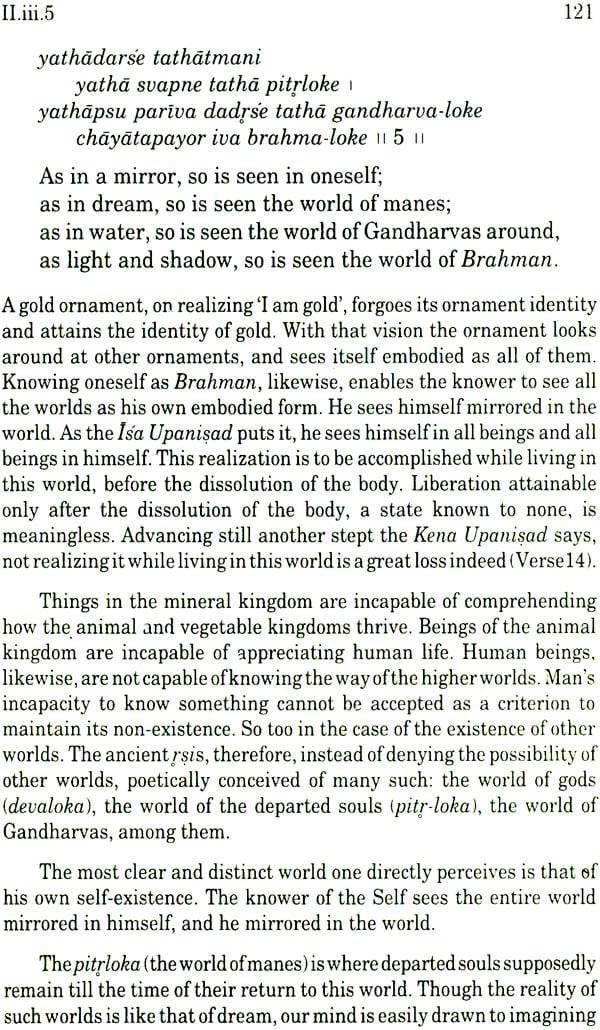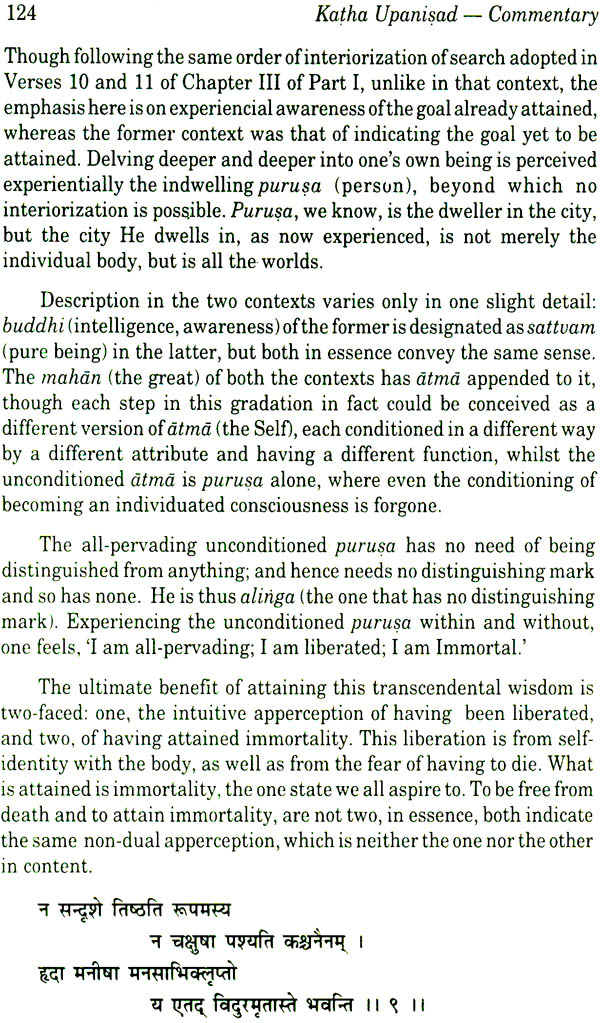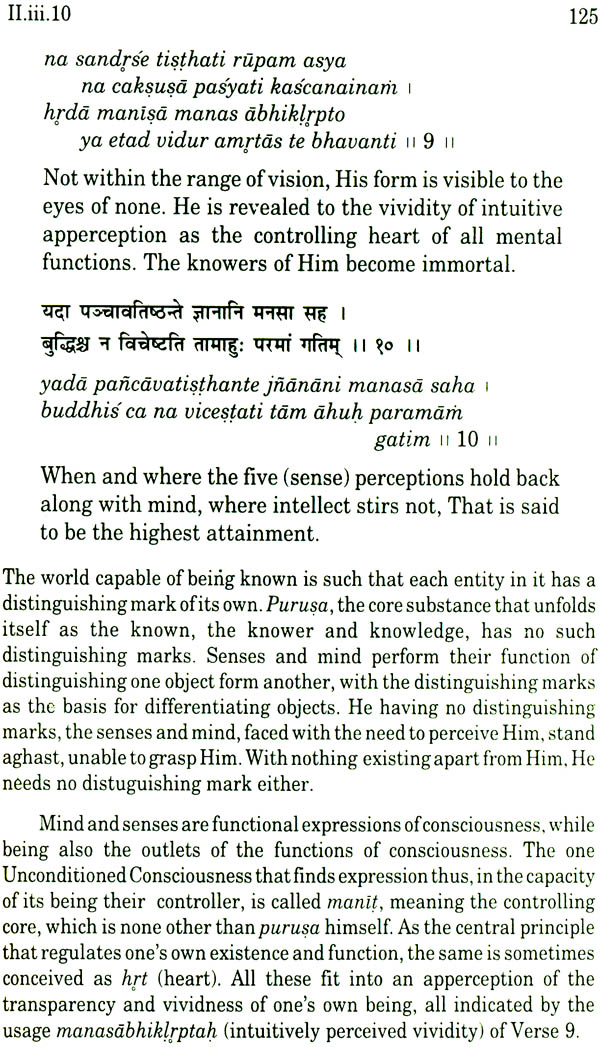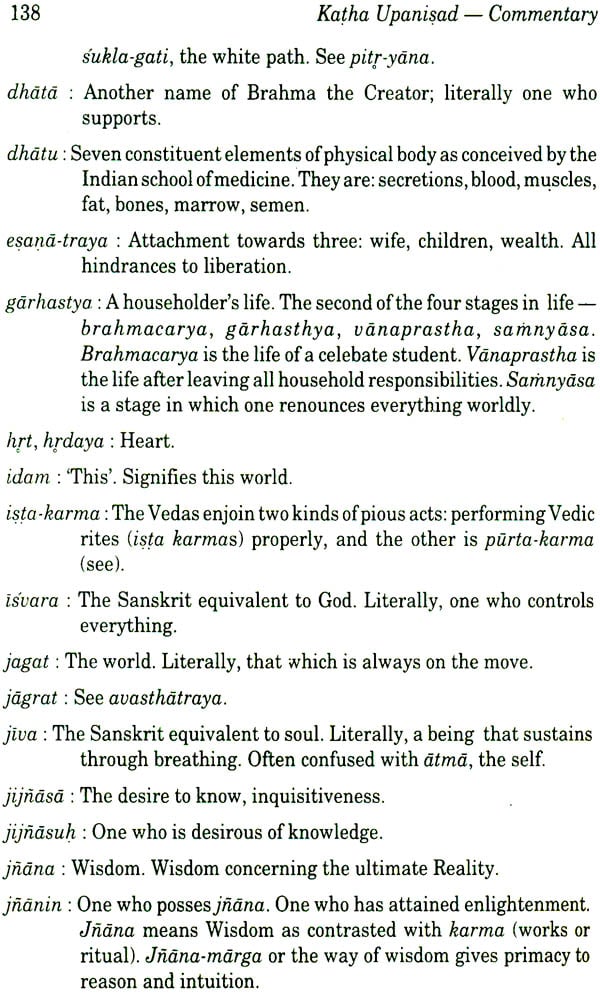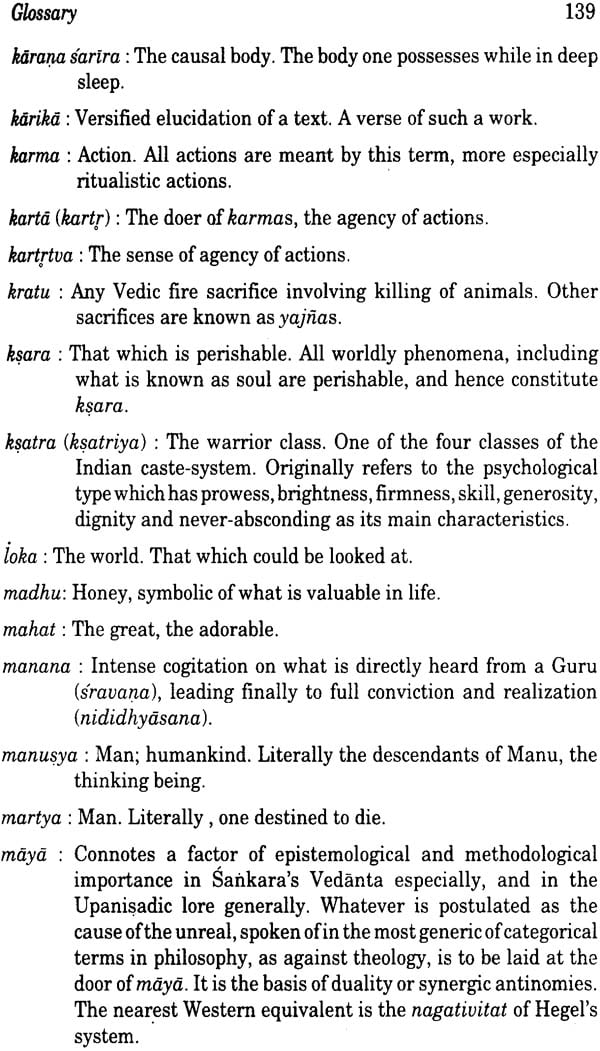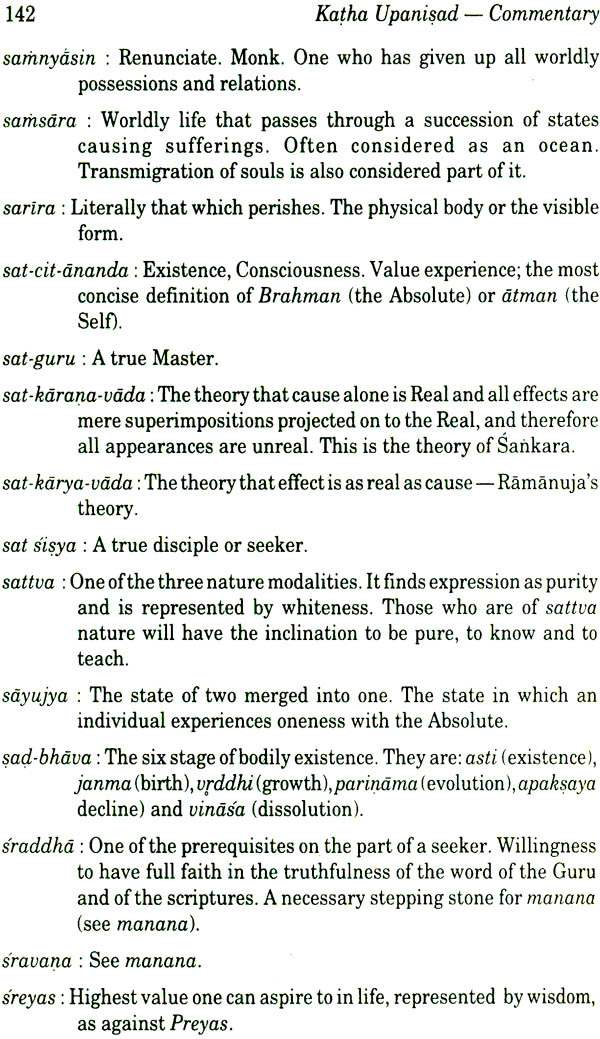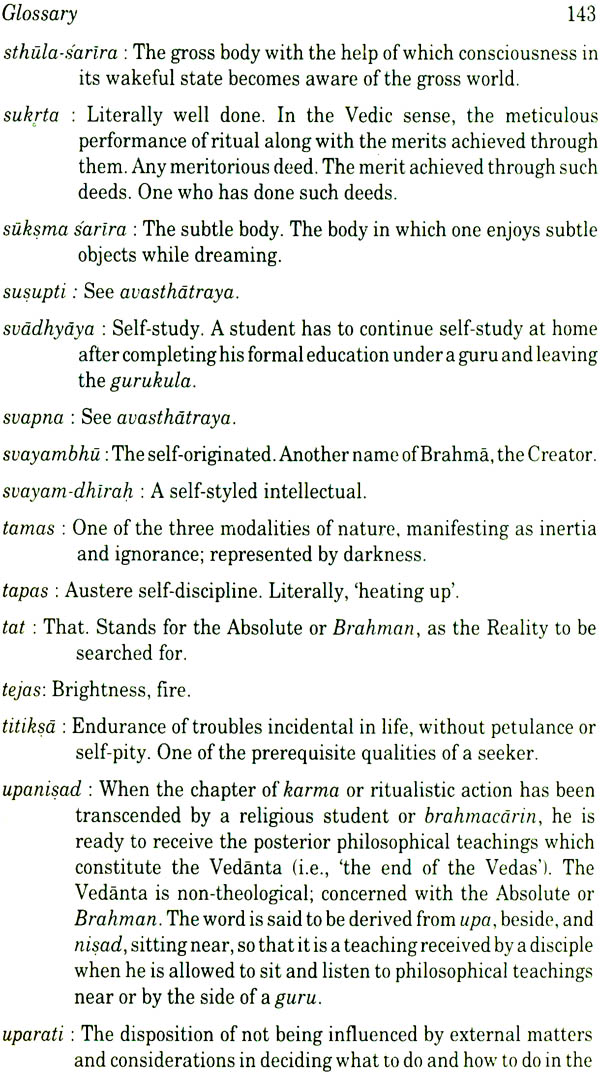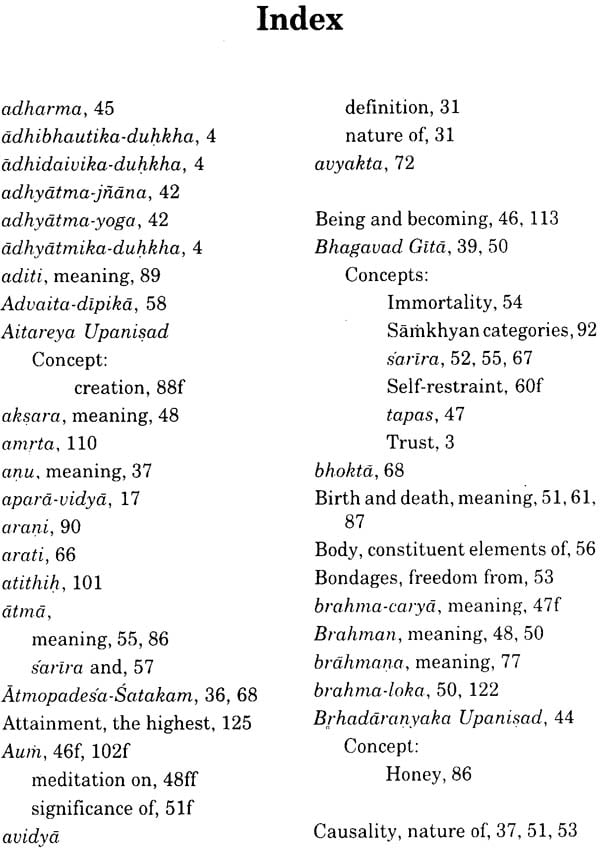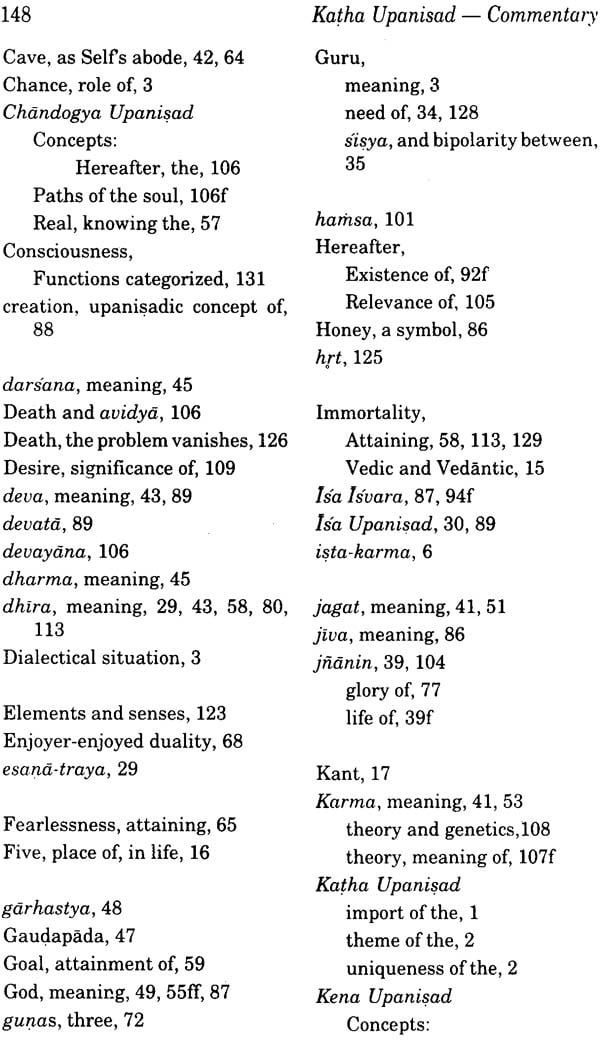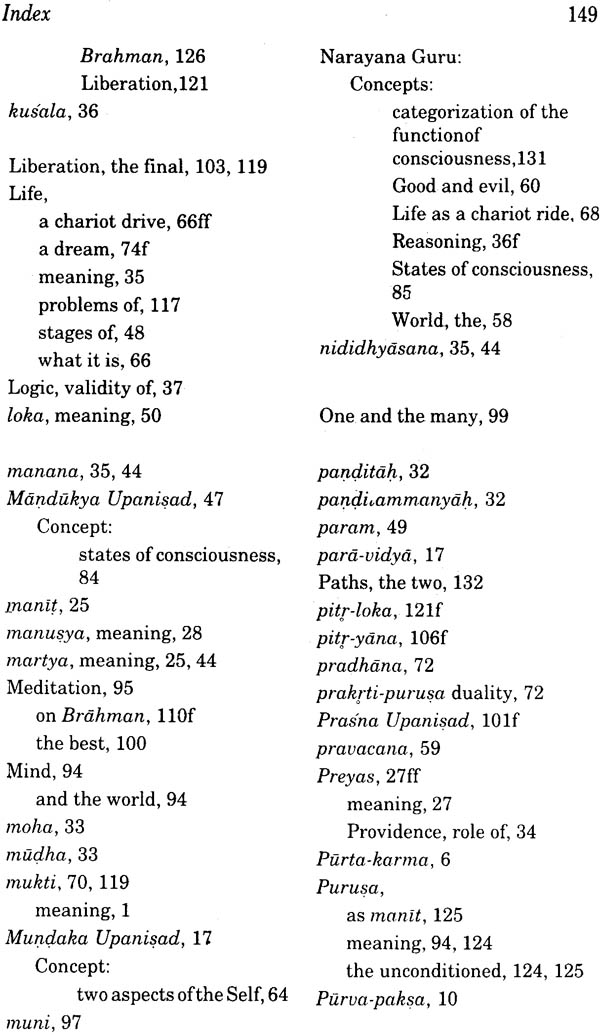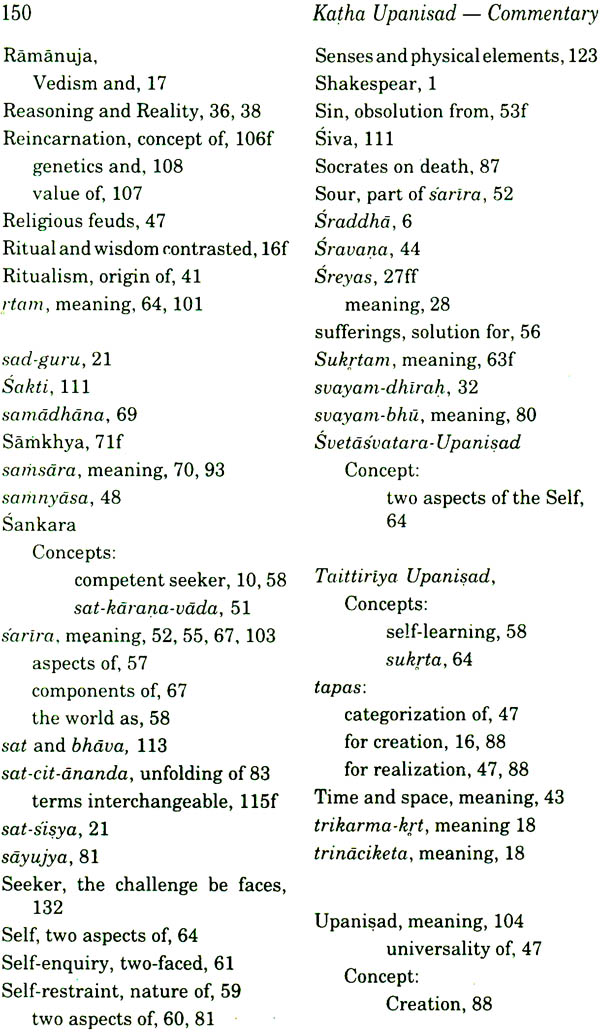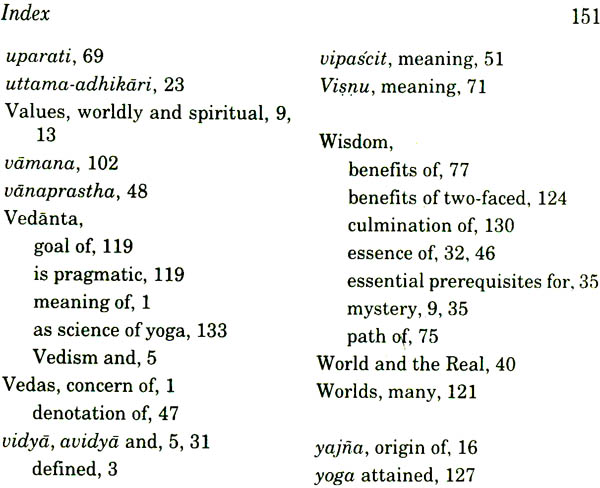
Katha Upanisad (with the original text in Sanskrit and Roman transliteration)
Book Specification
| Item Code: | IDF274 |
| Author: | Swami Muni Narayana Prasad |
| Publisher: | D. K. Printworld Pvt. Ltd. |
| Language: | with the original text in Sanskrit and Roman transliteration |
| Edition: | 2004 |
| ISBN: | 9788124601105 |
| Pages: | 157 |
| Cover: | Paperback |
| Other Details | 8.4" X 5.4" |
| Weight | 230 gm |
Book Description
From the Back of the Book:
Man has always been perplexed with the 'now' and 'hereafter' of his worldly existence. The enigma, called life, with all its attendants uncertainties and everyday strifes and irritants, continues ti defy experimental / realistic investigation - despite all the existing advances in science. We still age, we still die. We are as mortal as ever. Life remains a mystery. And death remains, in Shakespearean phraseology, "the undiscovered country".
A masterpiece among the writings of its genre, Katha Upanishad attempts to unravel the mystery of death - though, in its totality, it is an insightful exposition of brahmavidya: knowledge of Absolute / Supreme Reality. In a well-devised dialectical situation, the Upanisads shows how a young seeker, calling upon Yama, none other than the God of Death himself, insists on knowing the "secret of all secrets," with specific questions, like: What is death? And what, if anything, continues to exist after death, and how? - the questions which the deity answers, amidst widely-ranged "wisdom teachings". Swami Muni Narayan Prasad here offers a lucid English version of this time-honoured Upanisad, together with exhaustive commentary, the original Sanskrit text and its Roman transliteration.
Written at a time when the profoundly symbolic Vedic yajnas/ rituals had degenerated into crass priestcraft, the Katha Upanishad not only has its historical importance, but counts among the landmark writings that have shaped India's heritage of spirituality and philosophic thought.
About the Author:
Swami Muni Narayana Prasad is presently Head of Narayana Gurukula, a guru-disciple foundation set up by Nataraja Guru, the disciple-successor of Narayana Guru. He has spent three years in Fiji teaching Indian philosophy and has traveled round the world giving classes. Became a disciple of Nataraja Guru in 1960 and was initiated as a renunciate in 1984. His published works in English include, Karma and Reincarnation - The Vedantic Perspective; Basic Lessons of India's Wisdom; Vedanta Sutras of Narayana Guru; Commentaries on the Katha, Mundaka, Prasna, Taittiriya and Aitareya Upanisads
WHEN I joined the Guruhula as a teenager, reciting the texts of the Upanisads, short ones in full and select portions of the long ones, was what I found most interesting in the daily routine of life there. I was taught the way of proper recitation by Nitya Chaitanya Yati, then one of the senior disciples of Nata raja Guru, and now the Guru and Head of the arayana Gurukula. And in some cases, Nataraja Guru directed us on how to introduce alterations that would better the traditional orthodox way of recitation. Years later I also began to teach the Gurukula children this recitation as well as the meaning of these Upanisads in as simple a way as possible. The texts thus recited and taught were compiled into a book we named the Guruhula-Dhyana-Manjusa. Upon my finally decidi ng to take sannyasa, Nataraja Guru gave me these words of direction:
Every sannyasin has his own pattern of sannyasa. You need not imitate me. As one who has been holding firm to the Upanisads from the very beginning, you may better adopt a life based on the firm ground of the Upanisads and their teachings. At that moment I resolved to dedicate myself to delving into the subtleties of the philosophical vision contained in the words of the Upanisads, In time I realised that the best way of doing this was to write down what I was able to see there. The Katha Upanisad was the first of these. The outcome was initially serialized in the Malayalam philosophical monthly The Gurukulam and later in the Gurukulam Quarterly published from the Narayana Gurukula Centre in the United States. Both were well received by readers and this inspired me to take up the other Upanisads as well. Years later upon re-reading what I had written on the Katha Upanisad, I felt that it lacked clarity, a natural defect of immature thought. So I rewrote the entire commentary, putting it into the shape you now see it in.
In the Gurukula, formal recitation of Upanisads accompanies the homa (symbolic fire-sacrifice) held on Sundays and special occasions such as the annual Gurukula convention. Nataraja Guru, in the discourse that customarily followed the homa, would elucidate on the text, giving important hints on the dialectical way of searching for the hidden wisdom of the Upanisad. These hints have constantly been guiding me in the writing of this commentary. Many vital points have also been highlighted, by a group of research scholars getting together and pondering over each of these verses. The present commentary, is thus the result of a collective effort.
In the meantime Guru Nitya Chaitanya Yati and I also took up the grand project of putting together the Narayana Gurukula's commentaries to all the ten major Upanisads: He was to write on the Brhadaranyaka and Chandogya and I, on the rest. Guru had already written a commentary to Mandukya. In effect I had to handle the remaining seven. My commentaries on the Isa Upanisad have already appeared in a different format in the Basic Lessons on India's Wisdom. The Brhadaranyaka commentary of Guru Nitya is already available in print in three volumes. The present book is part of this project. Towards the materialisation of this project, Messers D.K. Printworld of New Delhi have started a new series entitled 'Rediscovering Indian Literary Classics'. Guru Nityas' Commentary on the Chandogya is in the making.
Kala Ramesh of Bangalore, a long-time associate of the Gurukula Movement, found time to edit the book carefully in spite of all her other responsibilities. She did it out of her sheer love for wisdom. A sannyasin is indebted to none and having no social obligation; I do not dare to express my indebtedness to her.
If I have at any point deviated from the familiar traditional way, it is less out of disrespect, and more out of a desire to state as clearly as I could what I found in these Upanisads. I was all the time guided by the great Masters, my own Guru and the light of modern scientific thought. What is substantiated basically is the Advaita philosophy of Sankara as revalued and restated by Sri Narayana Guru.
With due homage to the long line of Gurus, beginning with Adi Narayana, I offer this mind-flower at the feet of Guru Nitya Chaitanya Yati.
ALL Upanisads teach brahmavidya, the Science of the Absolute, whose ultimate goal is to free the seeker from the tangle of worldly trials and tribulations of day-to-day life. This freedom is known as mukti or moksa.
The Upanisads appear as appendices to the four Vedas: Rg, Yajur, Sama and Atharva. The Vedas are the primordial expression of knowledge of the Aryan culture and the most ancient of all recorded material. The Yajurveda has two declensions: 8ukla (the white) and Krsna (the black), and the Katha Upanisad forms part of the latter.
Vedanta is the name popularly used for the wisdom of the Upanisads, though, literally meaning 'the end of knowledge', veda meaning. knowledge, and anta, end. It is so called because the Upanisads constitute the terminal part of the Vedas, and philosophically, it is the wisdom beyond which nothing remains to be known.
The Vedas concern themselves mainly with rituals called yajnas, such as burnt.sacrifices. Though yajnas were highly symbolic of pure wisdom to start with, in the long run they degenerated into exercises in priestcraft, and those who performed them became completely oblivious of the real import. To salvage the submerging beacon of wisdom from the corrupted current of Vedic ritualism, the Katha Upanisad made its dramatic apprearance.
This Upanisad unravels the mystery of death, and in the course of it, expounds the whole of brahmavidya. Death and life are both a mystery; one meaningless without the other. But man, in his ignorance is entranced with life and abhors death the inevitable. He is terrified of advancing old-age and the approach of death, and remains disturbed like Shakes pear's Hamlet who says, "death, the undiscovered country,
from whose bourn no traveller returns, puzzles the will". Science too stands puzzled before this inevitable phenomenon of life. No one knows exactly what death is, what happens at death and what, if anything, continues to exist after death, and how. It is around this enigma that the teaching of the Katha Upanisad revolves. The God of death himself teaches Naciketas, the secret of death - the immortality of the Real.
The setting of this Upanisad is the aftermath of one of the most famous yajnas - the Visvajit meaning, the conqueror of the universe. At the close of such rituals, it is enjoined in the Vedas that the sacrificer should gift all his worldly belongings to the priests. Vajasravas, the man who here has conducted the Visvajit, is shown giving priests a daksina of cows too old to eat and drink, too old to bear young or yield milk, symbolic of how far Vedic ritualism had degenerated. Giving away useless cows as gift has the double benefit of relieving the giver of the burden of having to maintain them, and effortlessly fulfilling a religious injunction. Such possiblities for exploiting situations do exist in ritualism. The seeker of Truth, uncorrupted by worldly interest and avarice, saves himself and others from such viciousness. To see the truth as it is needs an uncorrupt and unprejudiced mind, and Naciketas, the young seeker in this Upanisad, the son of Vajasravas, is one such. Little children, as Jesus taught, possess an innocence which deserves the Kingdom of Heaven. The Katha Upanisad, both historically and philosophically, thus occupies a unique position in Indian thought.
om saha nav avatu / saha nau bhunaktu /
saha viryam karavavahai I tejasvi nav adhitam astu /
ma vidvisavahai //
om santih. / santih. / santih //
May (God) protect us both. May He save us both. (May both of us enjoy together). May we attain vigour together. Let what we learn be illumined. May we not be hostile to each other.
Aum Peace! Peace! Peace!
Wisdom teaching takes place between master and disciple - a dialectical situation where the two are counterparts, between whom wisdom becomes illumined. The need for rapproachment between a true master (sad-guru) and a true disciple (sat-sisya) in the wisdom-teaching context has been sufficiently made clear in the Chapter 'Guru and Sisya' of the book The Word of the Guru by Nataraja Guru. The establishment of this bipolarity is a rare occurrence, as a favourable chance element it has a major role to play. The present Peace Invocation is a prayer of the master and the disciple together for strengthening the bond between them, so that an effective and fruitful illumination of wisdom may occur. The finality of wisdom is attained only by those who seek it for its own sake, and are satisfied with nothing less than the ultimate Truth. Though one is an enthusiastic seeker, one need not necessarily gain wisdom if living under unfavourable circumstances. Many, in spite of favourable conditions, fail to gain wisdom as their desire and resoluteness are not strong enough. Sometimes true seekers, though blessed with favourable circumstances and a strong mind, are deterred, finding no true guide. Chance, or the grace of God alone, brings all these elements together. The prayer here asks for this grace. Secret wisdom (the meaning of the word upanisad), remains a secret, of no value to others and to posterity, unless imparted by a master to a true seeker. No master true to the word Guru, which means dispeller of darkness, can keep his wisdom concealed; he necessarily has to expose himself - his self - to the one who seeks. Wisdom is thus illumined, and both the master and the disciple become self-satisfied, the former in having played his true role and the latter in experiencing the fulfilment of life. Both together therefore pray for such an illumination and fulfilment.
The love and compassion of the master towards the disciple and the disciple's trust in the Guru and his words are the main cementing elements in their mutual adoption. A disciple suspicious of the veracity of the Guru's teaching, in effect, doubts Truth itself, and as the Bhagavad Gita reminds, 'The suspicious one perishes' (IV.40). Whole- hearted trust in the Truth and the Guru and an earnest and dedicated attempt on the part of the seeker enable him to attain the goal. The prayer here is thus also for both master and disciple to be saved from mutual distrust and hatred.
Wisdom is sought for nothing other than the peace it brings. According to Indian Philosophy, three kinds of suffering are appeased on gaining Wisdom: self-caused sufferings (adhyatmika duhkha). those caused by others (adhibhautika duhkha) and the ones caused by God or the natural course of events (adhidaivika duhka)The three invokings to bestow peace indicate the desire for the appeasement of all three kinds of suffering.
| Preface | V |
| Introduction | 1 |
| | |
| Chapter I | 5 |
| Chapter II | 27 |
| Chapter III | 63 |
| | |
| Chapter I | 79 |
| Chapter II | 99 |
| Chapter III | 117 |
| Glossary | 135 |
| Index | 147 |
